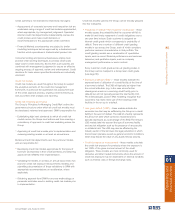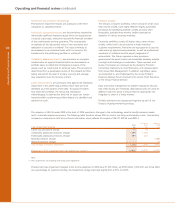RBS 2005 Annual Report Download - page 90
Download and view the complete annual report
Please find page 90 of the 2005 RBS annual report below. You can navigate through the pages in the report by either clicking on the pages listed below, or by using the keyword search tool below to find specific information within the annual report.
88
Operating and financial review
Risk organisation
Divisional CEOs are specifically responsible for the
management of risk within their divisions. As such, they are
responsible for ensuring that they have appropriate risk
management frameworks that are adequate in design, effective
in operation and meet minimum Group standards.
Divisional CEOs are supported by divisional Chief Risk
Officers (CROs) and Chief Financial Officers (CFOs). An
important element that underpins the Group’s approach to the
management of all risk is independence. In the case of CROs,
it is enforced by joint reporting lines, both operationally to the
divisional CEO and functionally to the Group Chief Risk Officer.
Operating and financial review continued
Credit risk
Key principles of credit risk management
The objective of credit risk management is to enable the Group
to achieve sustainable and superior risk versus reward
performance whilst maintaining credit risk exposure in line with
approved risk appetite.
Group Risk Management is responsible for setting standards
for maintaining and developing credit risk management
throughout the Group. This is achieved via a combination
of governance structures, credit risk policies, control
processes and credit systems collectively known as the
Group’s Credit Risk Management Framework (“CRMF”).
The framework is defined in detail in the Group’s ‘Principles for
Managing Credit Risk’.
The key principles for credit risk management as defined in the
CRMF include:
•Approval of all credit exposure must be granted prior to any
advance or extension of credit.
•An appropriate credit risk assessment of the customer and
related credit facilities must be undertaken prior to approval
of credit exposure. This must include a review of, amongst
other things, the purpose of the credit and sources of
repayment, compliance with affordability tests, repayment
history, capacity to repay, sensitivity to economic and market
developments and risk-adjusted return.
•The Board delegates authority to Executive Advances
Committee, Group Credit Committee and divisional credit
committees.
•Credit risk authority must be specifically granted in writing to
all individuals involved in the granting of credit approval,
whether this is exercised personally or collectively as part of
a credit committee. In exercising credit authority, the
individuals must act independently and with balanced
commercial judgement.
•Where credit authority is exercised personally, the individual
must not have any responsibility or accountability for
business revenue generation.
•All credit exposures, once approved, must be effectively
monitored and managed and reviewed periodically against
approved limits. Lower quality exposures are subject to a
greater frequency of analysis and assessment.
•Customers with emerging credit problems must be identified
early and classified accordingly. Remedial actions must be
implemented promptly to minimise the potential loss to the
Group.
•Portfolio analysis and reporting must be used to identify and
manage credit risk concentrations and credit risk quality
migration.
Each Division must establish its own CRMF consistent with the
Group CRMF. Divisional credit departments are responsible for
maintaining the CRMF and ensuring that asset quality is within
specified parameters. Divisional credit departments are
independent of business management and have no direct
responsibility or accountability for revenue generation. This
independence is supported by the divisional head of credit
having dual reporting lines to the both the divisional CEO (via
the divisional Chief Risk Officer) and to the Head of Group
Credit Risk.
GRM undertakes regular assessment of the effectiveness of
each divisional CRMF to ensure it complies with Group
standards and is appropriate for the business being
undertaken. GRC and the GEMC review reports on the Group’s
portfolio of credit risks on a monthly basis.
Credit approval process
Different credit approval processes exist for each customer
type in order to ensure appropriate skills and resources are
employed in credit assessment and approval whilst following
the key principles relating to credit approval.
Wholesale risk exposures are aggregated to determine the
appropriate level of credit approval required and to facilitate
consolidated credit risk management.
























